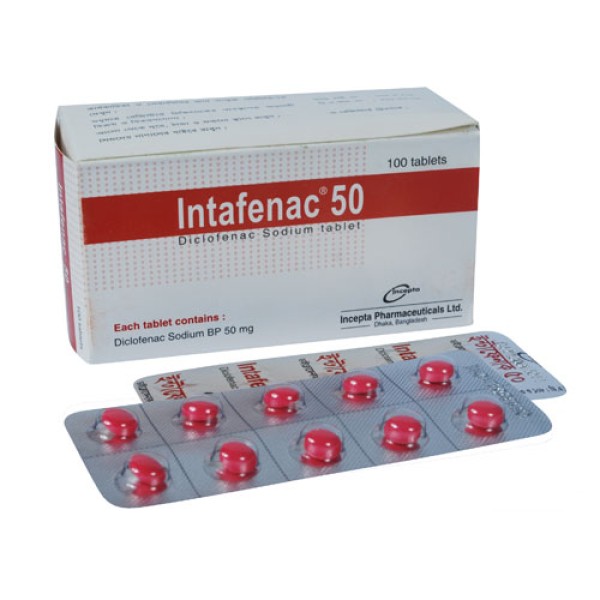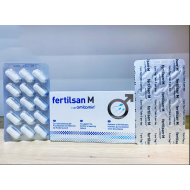
- Stock: In Stock
- Brand: Incepta Pharmaceuticals
- Product ID: Diclofenac Sodium
100% Secure Payment

This Item is for pre order
Intafenac 50
Description
Diclofenac is a potent Non-Steroidal Anti-Inflammatory Drug (NSAID) with marked analgesic and antipyretic properties. The actions of Diclofenac appear to be associated principally with the inhibition of prostaglandin synthesis. Diclofenac inhibits the synthesis of prostaglandins by inhibiting cycloxygenase enzyme. It also has some uricosuric effect.
Lidocaine is the most widely used local anaesthetic drug. It acts more rapidly and is more stable than most other local anaesthetics. It is a very useful surface anaesthetic. Like other local anaesthetic, Lidocaine impairs the generation and conduction of the nerve impulses by slowing depolarization.
Indications
Intafenac has got the following therapeutic uses:
Postoperative pain
*Control of pain and inflammation in orthopaedic, dental and other minor surgery
*Acute trauma and fractures
Low back pain and other acute musculoskeletal disorders such as periarthritis (e.g., frozen shoulder), tendonitis, tenosynovitis, bursitis, sprains, strains, dislocations, fractures
Crystal deposition in the joints ( pyrophosphate arthropathy) and other joint disorder.
Renal colic pain
Osteoarthritis
Juvenile chronic arthritis
Ankylosing spondylitis
Acute gout
Rheumatoid Arthritis
Severe migraine attacks
Pain in dysmenorrhea
Intafenac Plus injection also contains Lidocaine Hydrochloride, which acts as a local anaesthetic. Therefore, the possibility of pain at the injection site, which is most likely to occur after intramuscular injection of normal Diclofenac, is minimized if Intafenac Plus injection is used.
Intafenac K is an immediate release tablet of Diclofenac Potassium that works by blocking the action of a substance in the body called cyclo-oxygenase. Cyclo-oxygenase is involved in the production of various chemicals in the body, some of which are known as prostaglandins. Prostaglandins are produced in response to injury or certain diseases and would otherwise go on to cause pain, swelling and inflammation.
Dosage & Administration
Intafenac 50
Adults: 1- 3 tablet (50 -150 mg) daily in divided doses preferably with food or after food.
Children: 1- 3 mg/kg body weight per day in divided doses.
Intafenac and Intafenac Plus injections are intended for intramuscular injection.
Adults: The dosage is generally one 75 mg ampoule daily. In severe cases (e.g. colic) the daily dose can exceptionally be increased to two ampoules of 75 mg, separated by an interval of a few hours. Alternatively, one ampoule of 75 mg can be combined with other dosage forms (tablets, suppositories) up to a maximum daily dosage of 150 mg.
In migraine attacks, clinical experience is limited to initial use of 1 ampoule of 75 mg administered as soon as possible, followed by suppositories up to 100 mg on the same day if required. The total dosage should not exceed 175 mg on the first day.
Children: In juvenile chronic arthritis, 1-3 mg of Diclofenac sodium/kg body weight daily in divided doses.
Elderly patients: The lowest effective dosage is recommended, commensurate with age and physical status or as prescribed by the physician.
Side Effects
Side-effects of Diclofenac is usually mild and transient. It is generally well tolerated. At the starting of the treatment, however, patients may sometimes complain of gastrointestinal discomfort, epigastria pain, eructation, nausea and Diarrhoea, headache and bleeding sometime may occur. Occasionally skin rash, peripheral oedema and abnormalities of serum transaminase have been reported.Very rarely reported side effects include activation of peptic ulcer, haematemesis or melena, blood dyscrasia (extensive usage). There have been isolated reports of anaphylactoid reactions.
The adverse effects due to Lidocaine mainly involve the CNS, are usually of short duration, and are dose related. The CNS reaction may be manifested by drowsiness, dizziness, disorientation, confusion, lightheadness, etc. Incase of eye drops ocular burning sensation or allergic reaction may occur in 5-10% patients.
Precautions
History of gastrointestinal ulceration, haematemesis or melaena, ulcerative colitis, Asthma or history of asthma, Crohn\'s disease, bleeding diathesis or haematological abnormalities. Patients with severe hepatic, cardiac or renal insufficiency or the elderly people, Current or previous high blood pressure ( hypertension) should be kept under close surveillance. All patients who are receiving long-term treatment with NSAID agents should be monitored as a precautionary measure (e.g., renal, hepatic function and blood counts).If abnormal liver function tests persist or worsen, clinical signs and symptoms consistent with liver disease develop or if other manifestations occur, Diclofenac sodium should be discontinued. Use of Diclofenac tablet in patients with hepatic porphyria may trigger an attack.
Use in Pregnancy & Lactation
Pregnancy: It should not be prescribed during pregnancy, unless there are compelling reasons for doing so. The lowest effective dosage should be used. These types of drugs are not recommended during the last trimester of pregnancy.
Lactation: Very small quantities of Diclofenac may be detected in breast milk, but no undesirable effects on the infant are to be expected.
The safety of Diclofenac eye drops in pregnancy & lactation has not been established and its use therefore is not recommended unless the potential benefit to the mother outweighs the possible risk to the child.
Over Dose
There is no typical clinical picture associated with an overdosage of Diclofenac. Specific measures such as forced diuresis, dialysis or haemoperfusion are unlikely to be helpful in eliminating NSAIDs because of their high protein-binding rate and extensive metabolism.
Storage
Store in a cool and dry place, protected from light.




























%20Pvt.%20Ltd./Movicol-Oral-Powder-190x190.jpg)
